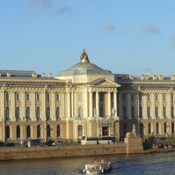
The Academy of Arts founded in Russia
By the decree of Senate on November 6 (17), 1757 in St.-Petersburg there was founded the Academy of Arts – the highest Educational institution in the field of plastic arts.
Back in the time of Peter I reign, it was decided to start teaching arts in the “academy of science and curious arts” conceived by the emperor. The teaching of painting and sculpture was introduced in the Academy of science during the reign of Catherine I. The drawing classes of the Academy however were intended only for scientific tasks. Only during the reign of Elisaveta Petrovna it was decided to establish an independent school for artistic education development.
In 1757 the chamberlain, count I.I. Shuvalov, a favorite of Elisaveta Petrovna, entered the Senate with the proposal to establish in Russia “The Academy of the three cardinal arts” (painting, sculpture, architecture) followed by a state order to establish the Academy on November 6 (17). The idea of the order was that for a harmonic development of the Russian culture not only the sciences were necessary but also the arts.
Originally the Academy of arts had been under the Moscow University though it was situated in St.-Petersburg, in Shuvalov’s mansion on Sadovaya street. The classes started here in 1758. The educational course lasted for 9 years and included the study of art of gravure, portrait, sculpture, architecture, etc.
The Academy was created as a center of preparation for national artists and architects. It was supposed that later they would form the teachers basis. The first professors were the foreigners: painters L.-J. Le Lorrent, J.-L. de Vally, L.-J.-F. Lagrenet; sculpture N.-F. Gillet; engraver G.-F. Shmidt. The architecture classes were taught by A.F. Kokorinov and J.-B. Vallen-Delamot. The first “pensioners”, young artists supported by the state treasury, were sent abroad for perfection – V.I. Bazhenov and A.P. Losenko.
In 1764 there were approved “The privilege and Charter of the Emperor Academy of the three cardinal arts” according to which the Academy was given the status of the emperor’s. In 18-19 centuries the Academy played a prominent role in the education of the Russian national artists. It was the centre of the artistic life of Russia.
After the revolution the Emperor Academy of Arts was abolished and replaced by Petrograd state free art educational workshops. In 1921 these workshops were given the former name of the Academy of arts. In 1933 the Academy became the all-Russian institution and in 1947 on its basis there was formed the Academy of arts of the USSR. In 1992 the Academy of arts of the USSR was reorganized into the Russian Academy of arts.
Lit.: Кондаков С. Н. Юбилейный справочник Императорской Академии художеств, 1714-1914. СПб., 1914; Лисовский В. Г. Академия художеств. Л., 1982; 225 лет Академии художеств СССР. М., 1983-1985; Оленин А. Н. Избранные труды по истории и деятельности Императорской Академии художеств. СПб., 2010; То же [Электронный ресурс]. URL:http://www.rasl.ru/e_editions/Olenin2010.pdf; Сборник материалов для истории Императорской С.-Петербургской Академии художеств за сто лет её существования. СПб., 1864-1866; Швидковский Д. Академия «знатнейших художеств» // Наше наследие. 2007. № 82.
Санкт-Петербургская Академия художеств. Б. д. URL: http://www.artsacademy.ru/.
Based on the Presidential Library’s materials:

